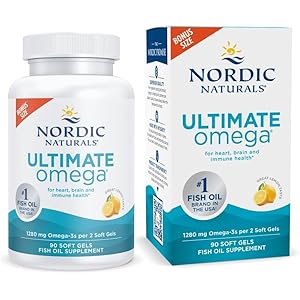Nordic Naturals Ultimate Omega, Lemon Flavor - 90 Soft Gels - 1280 mg Omega-3 - High-Potency Omega-3 Fish Oil Supplement with EPA & DHA - Promotes Brain & Heart Health - Non-GMO - 45 Servings
$34.64 (as of May 19, 2025 11:59 GMT +00:00 - More infoProduct prices and availability are accurate as of the date/time indicated and are subject to change. Any price and availability information displayed on [relevant Amazon Site(s), as applicable] at the time of purchase will apply to the purchase of this product.)Understanding Macronutrients
Macronutrients are the nutrients that provide the energy necessary for our bodies to function. They are categorized into three main types: carbohydrates, proteins, and fats. Each macronutrient plays a unique role in maintaining bodily functions, supporting growth, and providing energy. Carbohydrates are the body’s primary energy source, while proteins are essential for building and repairing tissues. Fats, although often misunderstood, are crucial for hormone production and nutrient absorption.
The Role of Micronutrients
Micronutrients, which include vitamins and minerals, are vital for overall health but are required in smaller amounts compared to macronutrients. They support various physiological functions, including immune response, bone health, and energy production. For instance, vitamin C is essential for the immune system, while calcium is crucial for maintaining strong bones. A balanced diet rich in fruits, vegetables, and whole grains can help ensure adequate intake of these essential micronutrients.
Phytonutrients: The Power of Plants
Phytonutrients, also known as phytochemicals, are compounds found in plants that provide health benefits beyond basic nutrition. They are not classified as essential nutrients but have been shown to support health in various ways, such as reducing inflammation and combating oxidative stress. Common sources of phytonutrients include colorful fruits and vegetables, legumes, nuts, and whole grains. Incorporating a variety of these foods into your diet can enhance your overall health and well-being.
The Interconnection of Macronutrients, Micronutrients, and Phytonutrients
While macronutrients, micronutrients, and phytonutrients serve different purposes, they are interconnected in promoting health. A diet that is rich in macronutrients but lacking in micronutrients and phytonutrients may lead to deficiencies and health issues. For example, consuming adequate protein is essential, but without sufficient vitamins and minerals, the body may struggle to utilize that protein effectively. Thus, a balanced diet that includes all three categories of nutrients is crucial for optimal health.
Macronutrient Ratios for Optimal Health
Determining the right macronutrient ratios can vary based on individual goals, activity levels, and health conditions. Generally, a balanced diet may consist of 45-65% carbohydrates, 10-35% protein, and 20-35% fats. However, athletes or individuals looking to lose weight may adjust these ratios to suit their specific needs. Consulting with a nutritionist can help tailor these ratios to individual requirements, ensuring that all macronutrients, along with necessary micronutrients and phytonutrients, are adequately represented.
Sources of Macronutrients
To achieve a balanced intake of macronutrients, it is essential to choose a variety of food sources. Carbohydrates can be found in whole grains, fruits, and vegetables, while proteins are abundant in meat, dairy, legumes, and nuts. Healthy fats are sourced from avocados, olive oil, and fatty fish. By diversifying food choices, individuals can ensure they are not only meeting their macronutrient needs but also obtaining the necessary micronutrients and phytonutrients that accompany these foods.
Micronutrient Deficiencies and Their Impact
Micronutrient deficiencies can lead to a range of health issues, including weakened immune function, poor bone health, and impaired cognitive function. Common deficiencies include vitamin D, iron, and calcium, which can arise from inadequate dietary intake or absorption issues. Addressing these deficiencies often requires dietary adjustments or supplementation. Regular health check-ups can help identify potential deficiencies, allowing for timely intervention to maintain overall health.
Incorporating Phytonutrients into Your Diet
Incorporating phytonutrients into your diet is as simple as eating a rainbow of fruits and vegetables. Different colors often indicate different phytonutrients, each with unique health benefits. For example, red foods like tomatoes are rich in lycopene, while green foods like spinach are high in lutein. By including a variety of colorful plant-based foods in your meals, you can enhance your intake of phytonutrients, supporting your health in a holistic manner.
The Importance of a Balanced Diet
A balanced diet that includes appropriate amounts of macronutrients, micronutrients, and phytonutrients is essential for maintaining health and preventing chronic diseases. Each nutrient plays a specific role in the body, and their synergistic effects can lead to improved health outcomes. Emphasizing whole, minimally processed foods can help ensure that you are getting a wide range of nutrients necessary for optimal health.


